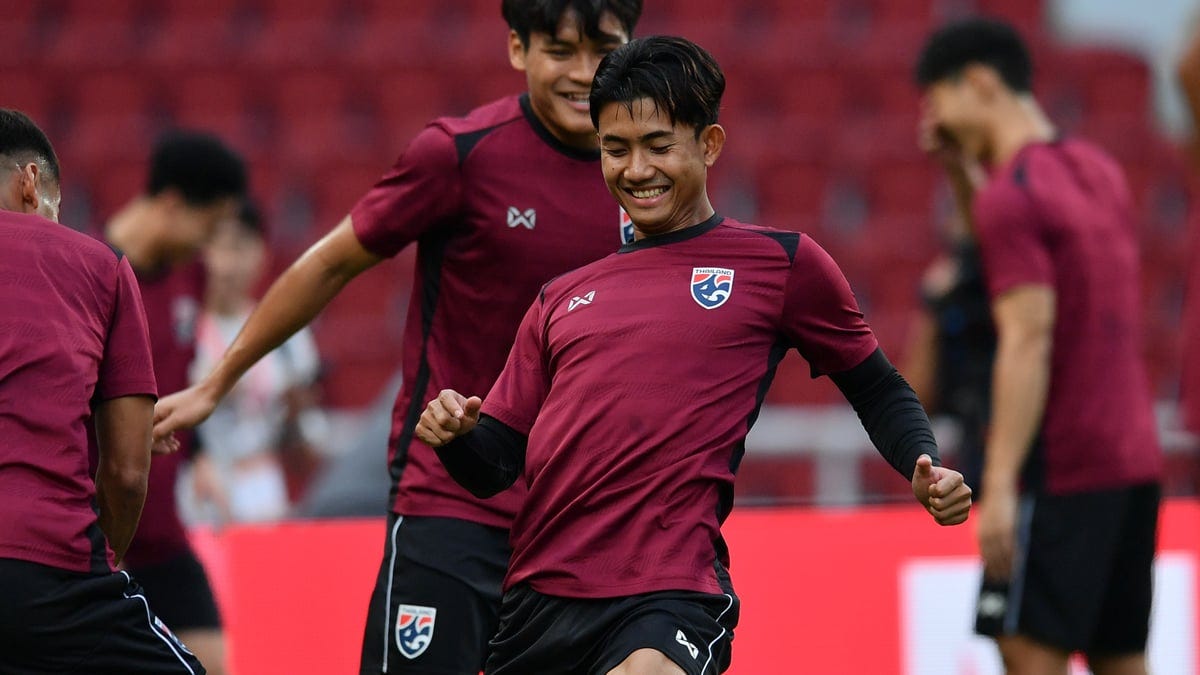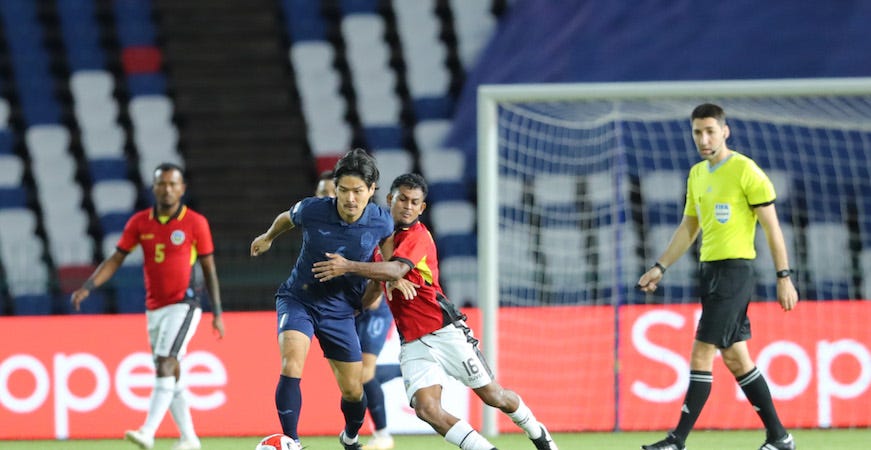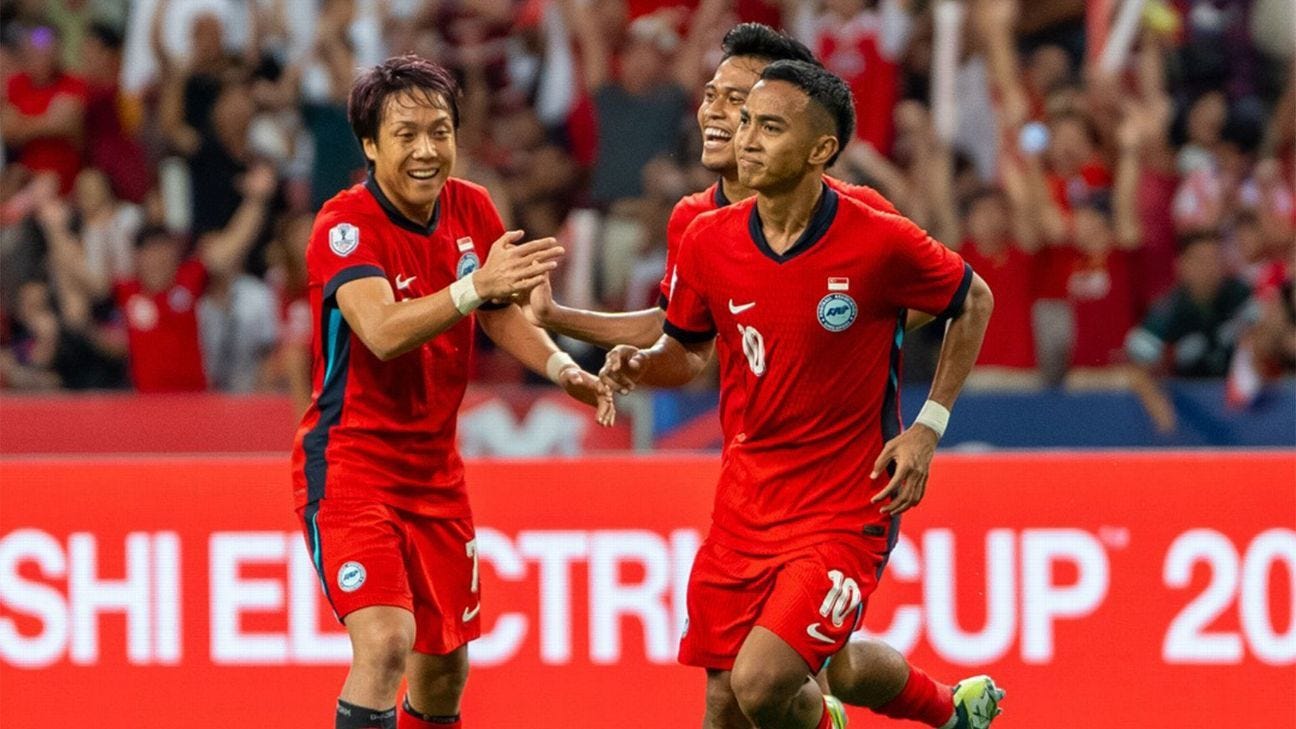ASEAN Cup Diary: Day 7
Can't believe it has been a week since the ASEAN Cup started!
After another one-day break between the matchdays, we are back with the second-to-last matchday of the ASEAN Cup group stage. This time, I am determined to not miss out on any actions from Group A having missed both matches on matchday three. With Malaysia now taking a bye for the matchday, it would be a great chance for other teams in contention to put themselves into a strong finishing position once the last matchday arrives. Without delaying any further, let’s get into the actions!
Cambodia 2-1 Timor-Leste
Continuing their impressive performances in the first two matchdays, Cambodia went out with a few changes, but the most notable one was Colombian-born striker Andrés Nieto starting and allowed Sieng Chanthea to move to the left winger position as a replacement for Kim Sokyuth. Meanwhile, Timor-Leste seemed to have retained most of their starting eleven and also went out with a 5-4-1 that they have been using during earlier matchdays. Something interesting that I did not notice during the first few days was Timor-Leste brought a very young squad to this tournament, and I mean very young. The oldest player in their squad was defender (#2) Almerito, who was 31 year old at the beginning of the tournament, and he was the only one in his 30s and one of the six players who were above 23. Considering this was a 26-man squad, that was a very low proportion of the squad being experienced players.
Right off the bat, (#10) Nieto came close to open the score as he tapped the ball in from close range, but VAR ruled out his goal due to his foul on the goalkeeper. Almost a perfect start to the tournament for Nieto. But Cambodia seemed to be a lot more positive compared to their first two matches, starting from the use of a box midfield/3+1 shape with one of the central midfielders (usually #6 Yudai Ogawa) splitting the centre-backs , to actually trying to counter press right inside of the opposition’s half whenever they lost the ball.
One of the early problems that they were showing, however, was the fact that they pushed a lot of players forward, including both full-backs, and left at most two centre-backs and a midfielder behind. This left them extremely vulnerable to counter-attacks because Timor-Leste tried to attack from out wide with players who could dribble, so they could dribble past one of the centre-backs and gained numerical advantage inside of the box. So far, though, they have not conceded a goal from that…yet.
There seemed to be a strong attacking preference down the left-hand side, with passes being made down the right to move Timor-Leste’s defensive block down that side, then quickly shifted back to the left for left-back (#11) Nick Taylor and Nieto to involve in the attacking sequence. But after 20 minutes, Timor-Leste still managed to defend well by overloading the wide spaces and limited the attacking threat that both Taylor and Nieto brought.
That rest defence problem actually hurt Cambodia 22 minutes in! Ogawa did not control the ball very well and lost it after a tackle, which allowed Timor-Leste to quickly counter and scored through a 2v2 situation. I have also noticed that the away side have been trying to unsettle (#2) Hikaru Mizuno on multiple occasions, including the situation that led to Timor-Leste’s opening goal. Mizuno was just unable to catch up with Timor-Leste’s attackers during their counter-attacks as he got left behind and had to scramble to get back to his position.
More long passes and through balls were being played in behind Timor-Leste’s backline by Cambodia now, seemed like they have increased their urgency and that was their way of trying to break the away side’s defensive block down and got back into the game. However, most attempts just ended up being mistimed or misplaced as Cambodia’s full-backs and wingers were caught offside or the ball went past them. The host also survived a scare when their keeper (#22) Reth Ly Heng did not catch the ball and allowed Timor-Leste’s (#8) Claudio Osorio (former Reading academy graduate!) to run in and push the ball into the net. Luckily the referee judged that a foul was made in the process, which kept the difference at one goal.
Cambodia has finally found the equaliser but that came from a corner situation. No Timor-Leste defenders were able to make first contact with the ball to clear it, which allowed right winger (#23) Sor Rotana to run into the 6-yard box and scored an easy goal for the host. Even though VAR had to check for a possible handball, the ball actually hit the shoulder of Rotana so there were no possible reasons to disallow the goal. 1-1 was the score at half time, even though Cambodia survived another scare when Taylor could not clear the ball properly and allowed Osorio to jump in and steal the ball, but Osorio’s shot eventually went wide of the post.
Besides from that error, I have actually been slightly impressed with Taylor so far. He looked quite positive whenever he had the ball, which was to be expected from a winger being used as a left-back. His overlapping runs were decent, and a few of his crosses came close to find players making runs into the box. His defensive ability was left to be desired, however, but, again, it was expected from a winger-turned-left-back.
I was also wondering why Nieto did not start the first couple of matches for Cambodia because his ability looked slightly better, and that was no disrespect to any of the local players. Playing almost as a poacher, the Colombian-born striker stayed in the channel between Timor-Leste defenders and looked to make runs in behind their backline. He also drifted to the left to work with Taylor and Chanthea to get the ball into the final third and progressed the team’s attacks.
It was possible to notice that Timor-Leste dropped their tempo significantly and their defensive shape dropped even closer to their own goal. At this point (30 minutes into the second half), Cambodia started to look struggle to break the opposition’s defensive block down as more and more attacks ended in corners instead of shots towards Timor-Leste’s goal. They have also used a lot more long passes, which ended up mostly with Nieto. He managed to bring the ball down but there was not a log of space to work with. Yet, as I was writing that, Nieto did exactly the opposite, which was bringing the ball down from a long pass and assisted (#14) Hav Soknet for an easy tap-in to regain the lead for Cambodia.
Summary
Probably not a surprise when Cambodia won against Timor-Leste considering they were the superior team in strength and position on the group table. But the away side’s defensive resilience and quick counter-attacks still shined through and it did cause some troubles for Cambodia at times. Once the host got back into the game, however, Timor-Leste just had no answer as they got squeezed into their own defensive third and was forced to defend attacks after attacks. Eventually, difference in quality came through and Cambodia found the two goals that they deserved, just…a little tougher than they hoped to be.
Singapore 2-4 Thailand
The Cambodia vs Timor-Leste match did not even end and both Singapore and Thailand had already taken the field and played for a few matches! Anyway, Singapore went out with almost their strongest lineup and the lineup that pretty much did not change from their clash against Cambodia, with only left-back (#3) Ryhan Stewart starting. Meanwhile, Thailand have also fielded their key players with goalkeeper (#1) Patiwat Khammai starting in goal and the likes of winger (#10) Suphanat Mueanta, central midfielder (#19) William Weidersjö, and striker (#9) Patrik Gustavsson headlining their lineup.
Just under 10 minutes into the match, and even though Thailand dominated the early minutes, it was Singapore who took the lead. From a quick goalkick by keeper (#1) Izwan Mahbud, he found striker (#20) Shawal Anuar running in behind the Thai defenders for a counter-attack. From outside of the box towards the right-side, Anuar took an outrageous shot that went past the reach of Khammai. Singapore fired the first shot in this fiery clash.
Whenever Indonesia had the ball, they still seemed to retain their build-up tendencies of using a 3+1 shape with central midfielder (#6) Shah Shahiran splitting the centre-back duo while (#7) Kyogo Nakamura stayed deeper and right behind Thailand’s striker duo. The goal was to play the ball down the left-hand side, where Stewart was making overlapping runs and worked with left winger (#10) Faris Ramli to get the ball into the opposition’s defensive third. At times, it was possible to see attacking midfielder (#16) Hami Syahin dropping deep to create a midfield three. Nothing that was significantly different from what they showed against Cambodia on matchday 2.
Thailand, meanwhile, seemed to be more wing-reliant than I thought they would be. They also used a 3+1 build-up shape, with defensive midfielder (#18) Weerathep Pomphan dropping to the left of the centre-backs and Weidersjö stayed just in front of the back three. This opened up the left flank for left-back (#6) Thitathorn Auksornsri to occupy and make some overlapping runs. But a number of attacks were coming down the right-hand side where Suphanat posed a significant threat and created a small, but interesting clash against Singapore’s Stewart. Suphanat tended to stay wide, which allowed right-back (#21) Suphanan Bureerat to move slightly inside and work alongside the central midfielders.

The main point here, though, was to create more space for Suphanat to dribble the ball and then create chances for Gustavsson in the middle. It is hard to find the type of #9 that Gustavsson is in Southeast Asia, the type that has the physicality to hold up the ball and contribute to the team’s play, while also being lethal in front of goal. It was no doubt that the away side was relying on these two to create their chances, but that did not mean that the threat did not come from the left-hand side as a few chances were also created down that flank.
Once again, I have to talk about Singapore’s build-up play because the sequence that led to their second goal was just sublime. I will let this video that I made (using Metrica Play) explain more detailed into why I think Singapore’s second goal just looked really good.
For the majority of the first half, Singapore was able to lock Suphanat down and kept him quiet. But a single situation during stoppage time where left-back Stewart just did not mark Suphanat tightly, and he made a good pass in behind the defence for left winger (#11) Anan Yodsangwal to receive, which he was able to and then laid the ball back for one of his oncoming teammates, who then assisted Gustavsson for a decent goal-scoring situation. 2-1 was the score at half-time, and a very good match from a tactical point of view so far. A lot of food for thoughts.
Early on into the second half and Thailand looked dangerous once more. They pushed Singapore back with their attacks and created a few chances towards Mahbud’s goal, and one of them resulted in a corner kick. While the initial corner did not pose any threat, Thailand got the second ball and Yodsangwal delivered a cross into the box, which he found Suphanat running in between two Singaporean defenders and scored. A bit of a poor marking and misunderstanding situation between the host’s defenders.
Thailand seemingly had regained the match’s dominance and have started to push Singapore back inside their own half. A lot more attacks were also created, but the away side could not find the footing and the position to score. On the other hand, the host have been restricted to counter-attacks, which they have not been able to construct properly due to how quick Thailand were able to regroup and restrict the space available for Singaporean players to work with.
An interesting thing to note was that with (#12) Nicholas Mickelson now coming on as a sub and filling into the right-back position, Thailand would be a lot more dangerous down the right with the presence of Mickelson and Suphanat. Singapore have also addressed that problem by taking Stewart out for a rest and brought on (#22) Christopher van Huizen, who started as left-back against Cambodia, on to fill in that exact same position.
The host survived a scare after another corner kick situation where no defenders were able to make first contact, which allowed centre-back (#3) Pansa Hemviboon to jump up at far post and score. For the third time of the day throughout the two matches combined, VAR intervened and judged that Singapore’s keeper Mahbud was fouled in the process, leaving the host still at a tie. With a bit more attacking power in (#13) Taufik Suparno and (#23) Abdul Rasaq Akeem coming on, Singapore was definitely hoping they could inject more energy into their attacking line for some counter-attacks in the last 15 minutes of the match.
Singapore still tried and created a few meaningful counter-attacks with the hope that they would regain the lead. So far into the second half, they have not been able to do that as their attacks would usually end up with just a few players joining and were easily outnumbered by Thailand. However, it could have been a good thing since Singapore also looked to retain what they could get from this match to enter the final matchday with less pressure. A point would have been enough, which they seemed to be happy to keep by pushing their players back and started defending. They have also restricted Thailand to less dangerous chances, which included long shots and shots that ended up being blocked.
Fourth time that VAR had to intervene another goal, and while I was not getting annoyed…yet, it had gotten on my nerves a bit. This time, though, they have confirmed the goal for Thailand as a similar situation to Pansa’s disallowed goal. The initial cross by Mickelson was not threatening, but they failed to clear the ball well and allowed Thailand to pick up the second ball. Another cross was swung back into the box where the ball found captain (#8) Peeradon Chamratsamee, who put the ball into the back of the net. From 2-0 down, Thailand have completed their comeback to 2-3. They have also found the fourth goal through a counter-attack, where Suphanat calmly laid a low cross in for (#14) Teerasak Poeiphimai to score. This must have felt like a pain for Singapore because they were trying to throw the sink at it and had two chances where they came very close to equalise.
Summary
It was a shame that this one had to end because it was a great match between two teams who look set to be on their way to the semi-final. Singapore looked genuinely good in the first half where they played good football at times, indicated by their second goal. But the opportunities that they had to do that were limited as Thailand’s quality was pushing them deeper and closer to their own goal. At some point, that quality just had to come through and created goals to the expense of Singapore’s defence and errors. These two teams, if they end up going into the semi-final together, will be the ones to look out for.
Once again, Group A has not failed to deliver dramas and goals. While considered as the superior team in the clash, Cambodia still had to work really hard to get all three points off of Timor-Leste, who continued to show the defensive resilience that have become a trademark for them since the start of the tournament. Meanwhile, Thailand and Singapore was a treat for the fans, even the neutrals. Good football was played, but the team with more quality came out on top, which was Thailand who has secured a spot in the semi-final. Their inferior goal difference should mean that they will also take the top spot, but when there is still a little chance for Singapore, never say never.
We will return with the actions of matchday 3 for Group B, where Vietnam is out to be the second team to secure a spot in the semi-final and the Philippines look to cause an upset. Meanwhile, Laos and Myanmar are hoping to secure their first win of the tournament and put themselves in a position to compete on the last day of the group stage. But until then, see you soon!





